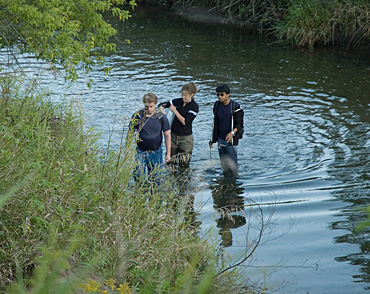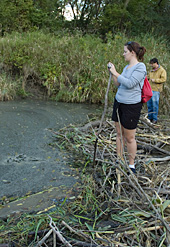AMES, Iowa -- When Fred MacVaugh was given a class assignment to explore Iowa State University's new nature preserve -- a 76-acre plot of largely underdeveloped land near Don Williams Park outside of Boone -- he couldn't wait to literally get his feet wet.
A former journalist who previously worked for the National Park Service, the 38-year-old MacVaugh was excited to wade Bluff Creek in the new Everett Casey Nature Center and Reserve. He is one of the new students in ISU's Master of Fine Arts (MFA) in creative writing and environment program -- the nation's first to now have its own nature preserve.
For their assignment, the new MFA students were teamed with second-year architecture graduate students from the College of Design to "map" the ISU land. The architecture students created the visuals through artistic graphic relief maps. The creative writing students provided the words.
Land donation by 1946 engineering graduate
The mapping project was the first for ISU students in the new preserve. The land, valued at $201,000, was donated to the university by Everett Casey of Detroit, Mich. -- a 1946 ISU engineering graduate -- who asked that it be preserved in its natural state. Casey took a writing class at Iowa State that he credits as being fundamental to what he later did as a Detroit-area attorney and owner of a manufacturing company.
As the initial assignment may suggest, the MFA faculty plan to put the Casey property to good use -- and not just with their own students.
"I think our mission, as far as our students go, is to give them as varied and rich an education as we can," said Steve Pett, an associate professor of English, who has been planning use of the land by MFA students. "And in Iowa, that's removed from what a lot of people think of as a quintessential environmental landscape. This [the nature preserve] is really vital for us, yet we can only introduce students to that landscape in certain limited ways. People from other disciplines bring additional knowledge and understanding to enrich our students' education."
That's what has MacVaugh so excited about the new creative resource. He sees it providing enrichment to his ISU educational experience.
"I'm personally more interested in what this resource could be as a pedagogical tool in just this situation [the initial class assignment] -- bringing people from all different disciplinary backgrounds together to think about place and what it means for us as a people," he said.
"All these different disciplinary areas can tell different stories based on what their focus or perspective is," MacVaugh continued. "A program like this MFA offers the opportunity to help to bring those various perspectives together to create a more holistic story. And really, that's what we need as a nation. One of the problems with the Park Service is there's still that nature/culture divide."

Students (L to R) Dan Wise, Brittany Van Hemert and Amrutesh Mohanty wade across Bluff Creek. (Downloadable photo available online)
Restoring property to a native prairie
Future plans at the Casey Nature Center and Reserve include restoring the property back into a native prairie. Other plans include adding a rustic structure, road, water line, hiking trails and a septic system.
Pett has plans to use the land with MFA students, alumni and visiting writers. But for those who have visions of simple romantic nature walks, think again.
"I don't think any of us thought that this will just be poets wandering around singing songs in the woods," Pett said. "We see it as a resource that gains in value as we exploit the strengths of other programs on campus.
"This is a place that already, I think, is helping our students sharpen their skills at observation and maybe refine their writing in a way that will make it more authoritative and effective," he said.
MacVaugh would agree. And he looks forward to his next visit to
the preserve for class.
